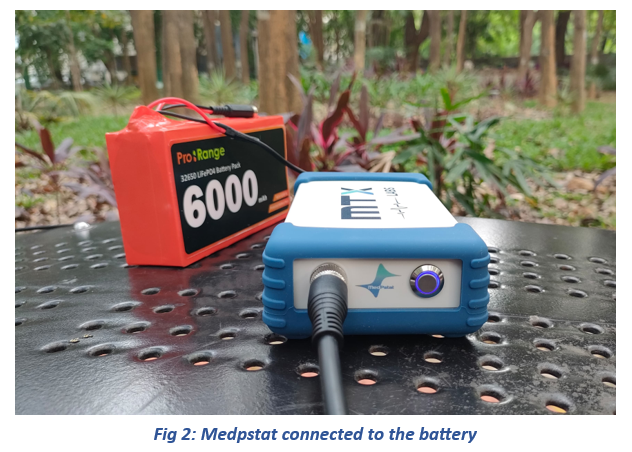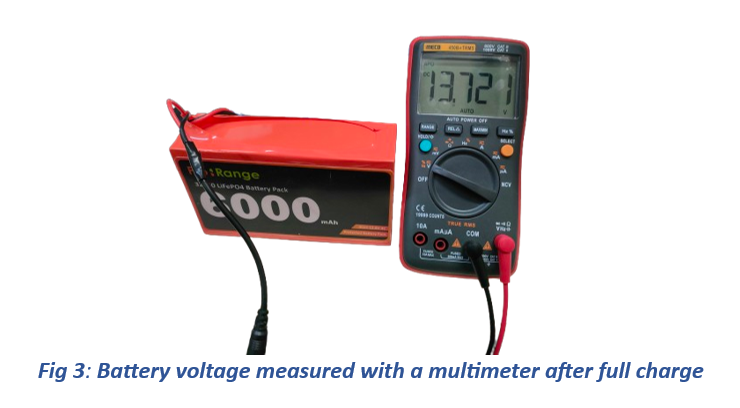This application note highlights Medpstat as a reliable and portable solution for electrochemical testing, especially in field applications. Unlike traditional potentiostats that require continuous external power and occupy significant bench space, the Medpstat is a lightweight, portable device that enables on-field testing with the help of an external battery. This makes it ideal for remote applications such as water quality monitoring, environmental sensing, corrosion measurement, and other field-based electrochemical measurements. The MedPstat series is available in three models — MedPstat Basic, MedPstat 1.0, and MedPstat 2.0 — offering users flexibility based on their specific experimental needs.
Introduction:
In this application note, we demonstrate the performance of the Medpstat 2.0 when powered by a 6000 mAh LiFePO₄ battery and evaluate its capability to operate reliably under various experimental conditions on a full charge. To assess the endurance and stability of the system, chronopotentiometry was conducted continuously at 1 V for a duration of 48 hours. This setup enabled us to evaluate the operational stability of the Medpstat 2.0 when powered solely by the battery, providing valuable insights into the reliability of battery-operated electrochemical testing over extended periods.
Apparatus Required:

In our experiments, a 6000 mAh LiFePO₄ battery with a nominal voltage of 12.8 V was used to power the Medpstat 2.0 instrument. All measurements and data analysis were conducted using the dedicated MedEplot software supplied with the system, enabling precise control of experimental parameters and ensuring accurate and reliable results.
Note: MedPstat input power requirement is 12V, 2A. Please don’t use any other voltage power source.
Experimental:

Before initiating the experiment, it is essential to connect the Medpstat to the battery. Begin by connecting the battery power supply to the Medpstat instrument (refer to Fig. 1 for a visual guide). Ensure that the correct power cable is used for this connection.
Result and Discussion:

Prior to experimentation, the LiFePO₄ battery was fully charged, reaching a maximum voltage of 13.7 V. After charging, the battery voltage was initially verified using a multimeter (refer to the image) and further confirmed through an Open Circuit Potential (OCP) test to ensure its proper charging status. Once validated, the battery was connected to the Medpstat 2.0 instrument. Chronopotentiometry was performed continuously at 1 V for a duration of 48 hours, with the parameters set through the MedEplot software, to evaluate the operational stability and endurance of the Medpstat when powered exclusively by the battery.
To evaluate the power consumption of our potentiostat models, we conducted similar tests using Medpstat Basic, Medpstat 1.0, and Medpstat 2.0. Each model was operated with its respective battery setup, and the current consumption was measured across different testing conditions, including both low-current and high-current electrochemical experiments. The results, summarized in the table below, provide a comparative understanding of how much current each model draws from the battery under varying load conditions.
| Current consumption | MedPstat 1.0 (Basic) | MedPstat 1.0 (Advance) | MedPstat 2.0 |
| Idle condition | 63.5mA | 68mA | 130mA |
| 1mA chrono | 76.5mA | 85mA | 152.3mA |
| Max current | 132.2mA (30mA) | 270mA (100mA) | 333mA (100mA) |
Based on theoretical calculations, the Medpstat 2.0 operating under chronopotentiometry at 1 mA is expected to draw approximately 152.3 mA of current. Using this value, the theoretical runtime was estimated by dividing the battery capacity (6000 mAh) by the current draw, resulting in an expected duration of approximately 39.40 hours (6000 mAh / 152.3 mA). Upon completion of the experiment, the actual runtime observed until complete battery drain was 34.13 hours. The deviation from the theoretical value is likely due to practical factors such as internal resistance, system losses, and the power consumption of auxiliary components.
Conclusion:
A continuous chronopotentiometry experiment at 1 V was carried out using the Medpstat 2.0, powered by a fully charged 6000 mAh LiFePO₄ battery. Theoretical calculations based on a current draw of 152.3 mA predicted a runtime of 39.40 hours. Experimentally, the device operated for 34.13 hours before complete battery discharge, with the deviation attributed to internal resistance and system losses. Similar high-current theoretical assessments estimated runtimes of 45 hours for the Medpstat Basic model, 22 hours for Medpstat 1.0, and 18 hours for Medpstat 2.0 under comparable conditions. These results highlight the suitability of MedPstat for low-power-consuming battery-powered on-field applications.

